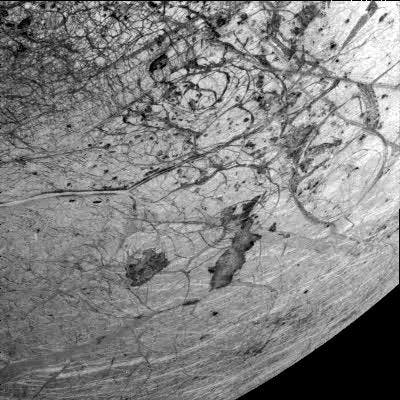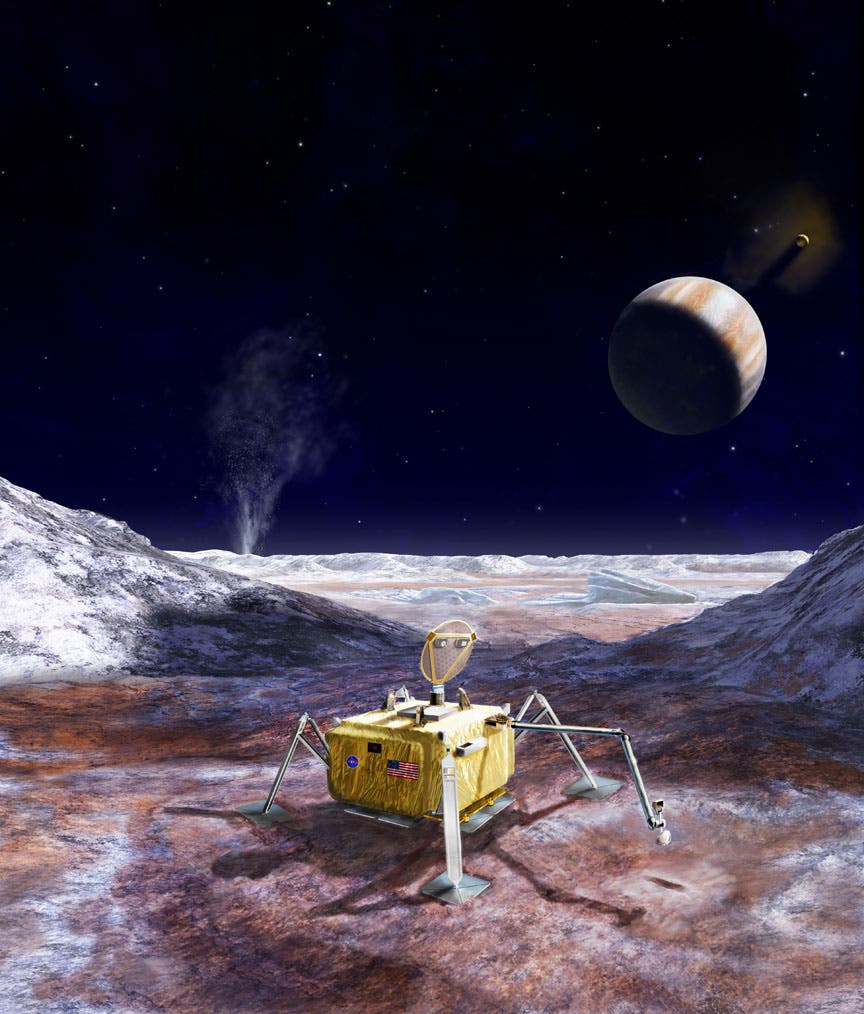Europa, the frozen but ocean-filled moon that orbits Jupiter is bombarded by a relentless flux of radiation. Day in and day out, Jupiter flings electrons and other particles towards it. These particles hit the ice and salt-rich surface of Europa, creating a soup of complex interactions that produce something otherworldly: they make Europa glow in the dark.

A song of ice and radiation
Cold Europa is already a hotspot of interest for astronomers. Although it is a frozen desert on the surface, astronomers believe it harbors liquid water beneath its icy crust, and based on what we know about its chemical make-up, it seems like a promising candidate for hosting life in this subsurface ocean.
But while the inside of the planed may be teeming with life (it’s probably not teeming, but you know), the surface is interesting in its own right. NASA astronomer Murthy Gudipati and colleagues recreated some of the interactions on Europa’s surface in the lab, exposing salted ice to energetic electrons as they would expect from Jupiter. They found that these interactions trigger a process called electron-stimulated luminescence. Simply put, it glows in the dark.
It’s an unusual process. You may be tricked into thinking it’s common for moons to glow by looking at our very own moon, bright on the night sky. But our moon isn’t glowing, it’s merely reflecting light from the Sun. Meanwhile, Europa truly produces its own light, even on the side that’s turned away from the Sun.

This is more than just a cool factoid that researchers have found about Europa. The work presented here is important for understanding Europa’s surface chemical composition and mineralogy, which in turn affect its habitability.
“We were able to predict that this nightside ice glow could provide additional information on Europa’s surface composition. How that composition varies could give us clues about whether Europa harbors conditions suitable for life,” said JPL’s Murthy Gudipati, lead author of the work published Nov. 9 in Nature Astronomy.
“If Europa weren’t under this radiation, it would look the way our moon looks to us—dark on the shadowed side,” Gudipati adds. “But because it’s bombarded by the radiation from Jupiter, it glows in the dark.”
What science is all about
The salty compounds react differently to the radiation and emit their own unique glimmer. By analyzing these glimmers at different wavelengths, astronomers can connect them to their “signatures” and assess the chemical make-up of the moon. This came as a bit of a surprise: researchers didn’t expect to see variations in the glow itself tied to different ice compositions. It was, the researchers call it, serendipity.
“Seeing the sodium chloride brine with a significantly lower level of glow was the ‘aha’ moment that changed the course of the research,” said Fred Bateman, co-author of the paper. He helped conduct the experiment and delivered radiation beams to the ice samples at the Medical Industrial Radiation Facility at the National Institute of Standards and Technology in Maryland.

So far, the researchers haven’t made any new discoveries about the chemistry of Europa. We’ll have to wait for NASA’s upcoming Europa Clipper mission, which will observe the moon’s surface over multiple flybys. These flybys (and the planned robot lander) could map Europa’s chemistry and gain insights about the sub-surface ocean (especially its salinity).
It’s uncommon for a lab experiment to be help a space mission know what to prepare for, but this is exactly what science is all about, says Gudipati.
“It’s not often that you’re in a lab and say, ‘We might find this when we get there,'” Gudipati said. “Usually it’s the other way around—you go there and find something and try to explain it in the lab. But our prediction goes back to a simple observation, and that’s what science is about.”
Europa Clipper is set to launch in the mid-2020s and it’s set to be one of the most exciting missions of the decade as it will investigate a part of the solar system that’s promising in regards to extraterrestrial life. Researchers are now reviewing the findings to see how Clipper’s scientific toolkit could detect variations in the moon’s glow.
Journal Reference: Laboratory predictions for the night-side surface ice glow of Europa, Nature Astronomy (2020). DOI: 10.1038/s41550-020-01248-1 , www.nature.com/articles/s41550-020-01248-1


